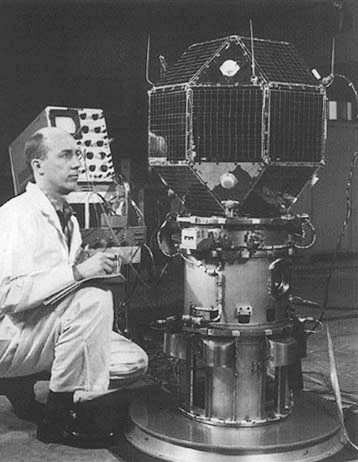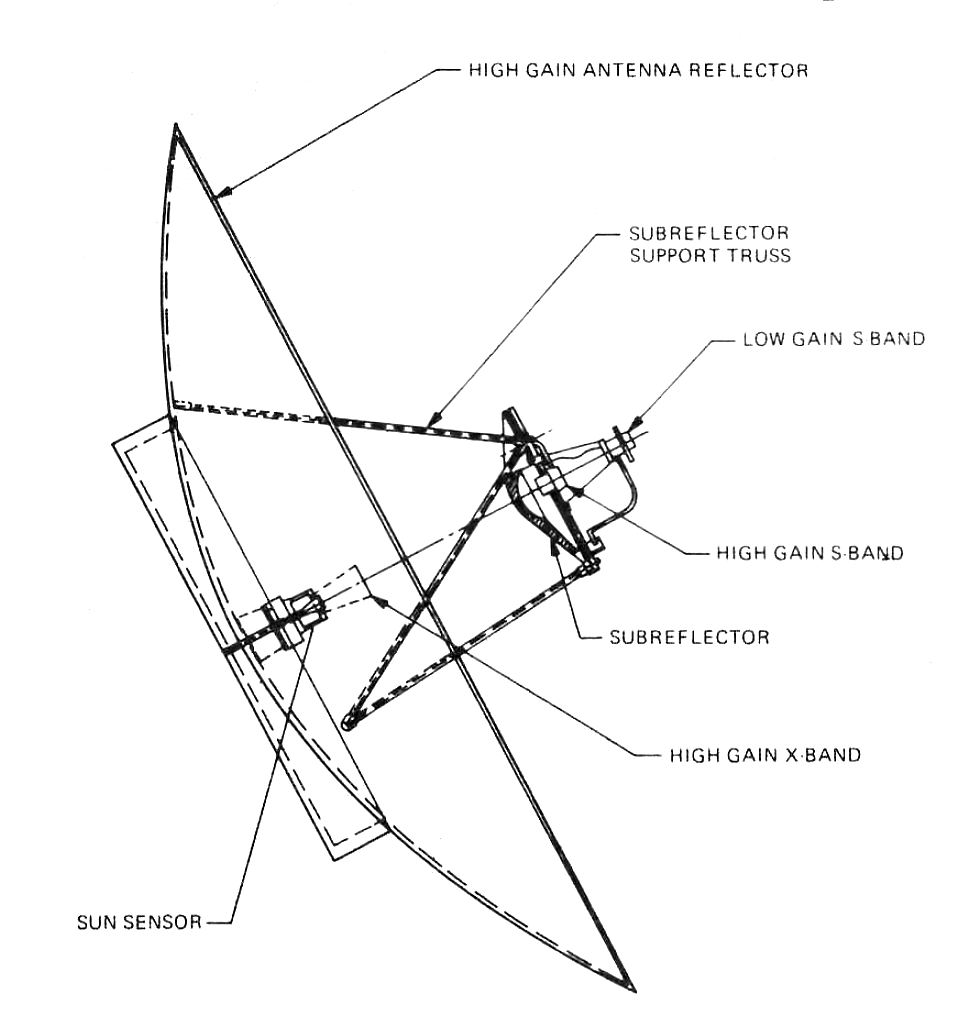|
MHW-RTG
The Multihundred-Watt radioisotope thermoelectric generator (MHW RTG) is a type of US radioisotope thermoelectric generator (RTG) developed for the Voyager spacecraft, ''Voyager 1'' and ''Voyager 2''. Each RTG has a total weight of 37.7 kg including about 4.5 kg of Pu-238"Space Nuclear Power" G.L.Bennett 2006 and uses 24 pressed plutonium-238 oxide spheres to provide enough heat to generate approximately 157 s of electrical power initially – halving every 87.7 years. Each RTG initially generated about 2400 Watts of thermal power. Conversion of the decay heat of the plutonium to electrical power uses 312 [...More Info...] [...Related Items...] OR: [Wikipedia] [Google] [Baidu] |
Radioisotope Thermoelectric Generator
A radioisotope thermoelectric generator (RTG, RITEG), sometimes referred to as a radioisotope power system (RPS), is a type of nuclear battery that uses an array of thermocouples to convert the heat released by the decay of a suitable radioactive material into electricity by the Seebeck effect. This type of generator has no moving parts. RTGs have been used as power sources in satellites, space probes, and uncrewed remote facilities such as a series of lighthouses built by the Soviet Union inside the Arctic Circle. RTGs are usually the most desirable power source for unmaintained situations that need a few hundred watts (or less) of power for durations too long for fuel cells, batteries, or generators to provide economically, and in places where solar cells are not practical. Safe use of RTGs requires containment of the radioisotopes long after the productive life of the unit. The expense of RTGs tends to limit their use to niche applications in rare or special situations. Beca ... [...More Info...] [...Related Items...] OR: [Wikipedia] [Google] [Baidu] |
Voyager Program
The Voyager program is an American scientific program that employs two robotic interstellar probes, ''Voyager 1'' and ''Voyager 2''. They were launched in 1977 to take advantage of a favorable alignment of Jupiter and Saturn, to Flyby (spaceflight), fly near them while collecting data for transmission back to Earth. After launch the decision was taken to send ''Voyager 2'' near Uranus and Neptune to collect data for transmission back to Earth. As of 2022, the Voyagers are still in operation past the outer boundary of the heliosphere in interstellar space. They collect and transmit useful data to Earth. , ''Voyager 1'' was moving with a velocity of , or 17 km/s, relative to the Sun, and was from the Sun reaching a distance of from Earth as of February 10, 2022. On 25 August 2012, data from ''Voyager 1'' indicated that it had entered interstellar space. , ''Voyager 2'' was moving with a velocity of , or 15 km/s, relative to the Sun, and was from the Sun reaching a distan ... [...More Info...] [...Related Items...] OR: [Wikipedia] [Google] [Baidu] |
Lincoln Experimental Satellite
The Lincoln Experimental Satellite series was designed and built by Lincoln Laboratory at Massachusetts Institute of Technology between 1965 and 1976, under USAF sponsorship, for testing devices and techniques for satellite communication. Development After the successful development and deployment of Project West Ford, a passive communications system consisting of orbiting copper needles, MIT's Lincoln Laboratory turned to improving active-satellite space communications. In particular, Lincoln aimed to increase the transmission capability of communications satellites ("downlink"), which was necessarily constrained by their limited size. After receiving a charter in 1963 to build and demonstrate military space communications, Lincoln focused on a number of engineering solutions to the downlink problem including improved antennas, better stabilization of satellites in orbit (which would benefit both downlink and "uplink"—communications from the ground), high-efficiency systems of ... [...More Info...] [...Related Items...] OR: [Wikipedia] [Google] [Baidu] |
Voyager 1
''Voyager 1'' is a space probe launched by NASA on September 5, 1977, as part of the Voyager program to study the outer Solar System and interstellar space beyond the Sun's heliosphere. Launched 16 days after its twin ''Voyager 2'', ''Voyager 1'' has been operating for as of . It communicates through NASA's Deep Space Network to receive routine commands and to transmit data to Earth. Real-time distance and velocity data is provided by NASA and JPL. At a distance of from Earth , it is the most distant human-made object from Earth. The probe made flybys of Jupiter, Saturn, and Saturn's largest moon, Titan. NASA had a choice of either doing a Pluto or Titan flyby; exploration of the moon took priority because it was known to have a substantial atmosphere. ''Voyager 1'' studied the weather, magnetic fields, and rings of the two gas giants and was the first probe to provide detailed images of their moons. As part of the Voyager program and like its sister craft ''Voyager ... [...More Info...] [...Related Items...] OR: [Wikipedia] [Google] [Baidu] |
Voyager 2
''Voyager 2'' is a space probe launched by NASA on August 20, 1977, to study the outer planets and interstellar space beyond the Sun's heliosphere. As a part of the Voyager program, it was launched 16 days before its twin, ''Voyager 1'', on a trajectory that took longer to reach gas giants Jupiter and Saturn but enabled further encounters with ice giants Uranus and Neptune. ''Voyager 2'' remains the only spacecraft to have visited either of the ice giant planets. ''Voyager 2'' was the fourth of five spacecraft to achieve Solar escape velocity, which allowed it to leave the Solar System. ''Voyager 2'' successfully fulfilled its primary mission of visiting the Jovian system in 1979, the Saturnian system in 1981, Uranian system in 1986, and the Neptunian system in 1989. The spacecraft is now in its extended mission of studying interstellar space. It has been operating for as of ; , it has reached a distance of from Earth. The probe entered interstellar space on November 5, 2 ... [...More Info...] [...Related Items...] OR: [Wikipedia] [Google] [Baidu] |
Nuclear Power In Space
Nuclear power in space is the use of nuclear power in outer space, typically either small fission systems or radioactive decay for electricity or heat. Another use is for scientific observation, as in a Mössbauer spectrometer. The most common type is a radioisotope thermoelectric generator, which has been used on many space probes and on crewed lunar missions. Small fission reactors for Earth observation satellites, such as the TOPAZ nuclear reactor, have also been flown. A radioisotope heater unit is powered by radioactive decay and can keep components from becoming too cold to function, potentially over a span of decades. The United States tested the SNAP-10A nuclear reactor in space for 43 days in 1965, with the next test of a nuclear reactor power system intended for space use occurring on 13 September 2012 with the Demonstration Using Flattop Fission (DUFF) test of the Kilopower reactor. After a ground-based test of the experimental 1965 Romashka reactor, which used urani ... [...More Info...] [...Related Items...] OR: [Wikipedia] [Google] [Baidu] |
Plutonium-238
Plutonium-238 (238Pu or Pu-238) is a fissile, radioactive isotope of plutonium that has a half-life of 87.7 years. Plutonium-238 is a very powerful alpha emitter; as alpha particles are easily blocked, this makes the plutonium-238 isotope suitable for usage in radioisotope thermoelectric generators (RTGs) and radioisotope heater units. The density of plutonium-238 at room temperature is about 19.8 g/cc. The material will generate about 0.57 watts/gram of 238Pu. The bare sphere critical mass of metallic plutonium-238 is not precisely known, but its calculated range is between 9.04 and 10.07 kilograms. History Initial production Plutonium-238 was the first isotope of plutonium to be discovered. It was synthesized by Glenn Seaborg and associates in December 1940 by bombarding uranium-238 with deuterons, creating neptunium-238. The subsequent decay via β− decay creates Plutonium-238. + → + 2 The neptunium isotope then undergoes β− decay to plutonium- ... [...More Info...] [...Related Items...] OR: [Wikipedia] [Google] [Baidu] |
Watt
The watt (symbol: W) is the unit of power or radiant flux in the International System of Units (SI), equal to 1 joule per second or 1 kg⋅m2⋅s−3. It is used to quantify the rate of energy transfer. The watt is named after James Watt (1736–1819), an 18th-century Scottish inventor, mechanical engineer, and chemist who improved the Newcomen engine with his own steam engine in 1776. Watt's invention was fundamental for the Industrial Revolution. Overview When an object's velocity is held constant at one metre per second against a constant opposing force of one newton, the rate at which work is done is one watt. : \mathrm In terms of electromagnetism, one watt is the rate at which electrical work is performed when a current of one ampere (A) flows across an electrical potential difference of one volt (V), meaning the watt is equivalent to the volt-ampere (the latter unit, however, is used for a different quantity from the real power of an electrical circuit). : ... [...More Info...] [...Related Items...] OR: [Wikipedia] [Google] [Baidu] |
Thermoelectric
The thermoelectric effect is the direct conversion of temperature differences to electric voltage and vice versa via a thermocouple. A thermoelectric device creates a voltage when there is a different temperature on each side. Conversely, when a voltage is applied to it, heat is transferred from one side to the other, creating a temperature difference. At the atomic scale, an applied temperature gradient causes charge carriers in the material to diffuse from the hot side to the cold side. This effect can be used to generate electricity, measure temperature or change the temperature of objects. Because the direction of heating and cooling is affected by the applied voltage, thermoelectric devices can be used as temperature controllers. The term "thermoelectric effect" encompasses three separately identified effects: the Seebeck effect, Peltier effect, and Thomson effect. The Seebeck and Peltier effects are different manifestations of the same physical process; textbooks may re ... [...More Info...] [...Related Items...] OR: [Wikipedia] [Google] [Baidu] |
GPHS-RTG
GPHS-RTG or general-purpose heat source — radioisotope thermoelectric generator, is a specific design of the radioisotope thermoelectric generator (RTG) used on US space missions. The GPHS-RTG was used on ''Ulysses'' (1), ''Galileo'' (2), '' Cassini-Huygens'' (3), and '' New Horizons'' (1). The GPHS-RTG has an overall diameter of 0.422 m and a length of 1.14 m. Each GPHS-RTG has a mass of about 57 kg and generates about 300 watts of electrical power at the start of mission (5.2 We/kg), using about 7.8 kg of Pu-238 which produces about 4,400 watts of thermal power.G. L. BennettSpace Nuclear Power: Opening the Final Frontier AIAA 2006-4191, 4th International Energy Conversion Engineering Conference and Exhibit (IECEC), 26–29 June 2006, San Diego, California The plutonium oxide fuel is in 18 GPHSs. Note that the GPHS are cuboid although they contain cylindrical plutonium based pellets. The GPHS-RTG units used on spacecraft were not created by NASA. They were ... [...More Info...] [...Related Items...] OR: [Wikipedia] [Google] [Baidu] |






